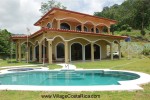Costa Rica’s Southern International Airport Update
Original: www.amcostarica.com
|
By the A.M. Costa Rica staff
 The project to build an international airport in the southern zone got a boost over the weekend when President Laura Chinchilla declared the concept to be in the public interest. That technical designation put a high priority on the $35 million project, which will start in 2012 to put in the bare bones of an international airport. Until then there are more studies and surveys. Significant planning and environmental work already has been done. For example, officials can say with certainty that the land proposed for the airport does not contain any of the famous pre-Columbian stone spheres of other important sites. An archaeological survey already has been completed. According to plans reviewed Saturday, the airport will have a runway from 2,000 to 2,600 meters, some 6,560 to 8,530 feet. The site already has been selected. It is fincas 9 and 10 in the Valle de Diquis in Sierpe de Osa. Officials also plan on getting two adjacent fincas for eventual expansion. Finca 9 is the property of the Instituto Nacional de Fomento Cooperativo, a public agency. It contains 233 hectares (about 576 acres). Finca 10 contains 261 hectares (645 acres). This is enough land for the runway, ramps, taxiways, a passenger terminal, parking and space for a fixed base operator to handle private aviation. Also needed will be a fire station, a control tower, navigation and landing systems and space for customs and immigration. The money for this project will come from the Dirección General de Aviación Civil, the national budget and an allocation the Ministerio de Obras Públicas y Transportes received from the International Civil Aviation Organization, officials said. Ms. Chinchilla said that the airport is important to generate employment and combat poverty. Real estate operators and tourism agencies are solidly in favor of the project. Ms. Chinchilla made a tour of the southern zone over the weekend and attended a meeting of the Golfito municipal council. There central government officials agreed to help the city with its tourism promotion. ————– NOTE: When the project is complete, owners in The Village of San Buenas will only be 30 minutes from their home. Now is a great time to purchase. This is the first official update regarding the international airport since former President Oscar Arias discussed it in July 2009. |
|






